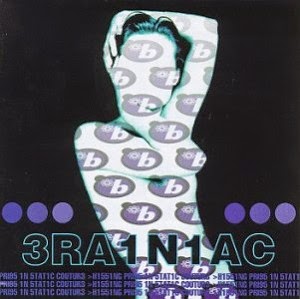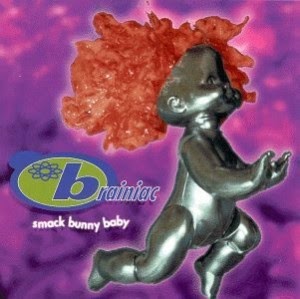BRAINIAC: HISSING PRIGS IN STATIC COUTURE (1996)
1) Indian Poker (part 3); 2)
Pussyfootin'; 3) Vincent Come On Down; 4) This Little Piggy; 5) Strung; 6) Hot
Seat Can't Sit Down; 7) The Vulgar Trade; 8) Beekeepers Maxim; 9) Kiss Me, U Jacked
Up Jerk; 10) 70 Kg Man; 11) Indian Poker (part 2); 12) Nothing Ever Changes;
13) I Am A Cracked Machine.
I seriously dislike the title of this album —
sounds like four unrelated words joined together through random selection. If
anything, it should have been named after one of its tracks — ʽHot Seat Can't
Sit Downʼ is a near-perfect description for its overall sound. Which has not
changed all that much since Bonsai
Superstar — but now it is even wilder, faster, uglier, and crazier, so if
you liked Superstar for all these
reasons, you are almost legally bound to develop an even higher appreciation
for Hissing Prigs.
Unless you already are an experienced consumer
of various sorts of noise, some of the small arch-experimental links may be
hard to fathom — if the industrially distorted «pan-fried» electric guitar duo
on ʽIndian Poker (part 3)ʼ does not kill you on the spot, just wait until you
get to the high-pitched electronic sirens on ʽIndian Poker (part 2)ʼ (boy, am I
glad they declined to end the album with ʽIndian Poker (part 1)ʼ — that would
probably have been the sonic torture to outshame all other sorts of sonic
torture). Even before that, the already
major crazy ʽ70 Kg Manʼ, running along at top speed to the sound of fizzed-out
punk guitars and dissonant overdubbed vocal harmonies of the chorus, is
interrupted midway through by a «bridge» of electronically treated barking
hounds — let me tell you, there's absolutely no fun in hearing this at top volume in headphones, and oh, my name
is Peter Townshend, by the way.
But do not make the mistake that it's all about
ugliness, either. Brainiac's chief influences are still the same — main cues
taken from the Pixies and, through them, from the Ramones and other punkers who
value fun, catchiness, and entertainment at least as much as they value
rebelliousness, schizophrenia, and social message. Once the initiation of ʽIndian
Pokerʼ has diligently driven out all the «wusses» and «pussies», ʽPussyfootinʼ really
turns out to be quite a conservative rock track, oddly adorned only with Tim
Taylor's inimitably screechy vocal style and a series of slightly deranged
babbling interludes. And no amount of hysterical electronic effects can disguise
the fact that ʽVincent Come On Downʼ is essentially just a solid slice of
classic punk-rock, with nothing particularly «avantgarde» about its basic chord
structure.
But do not make the mistake that it's really
all so simplistic. The above-mentioned ʽHot Seatʼ, for instance, starts off
with quite a tricky guitar riff and an even trickier time signature, well
worthy of King Crimson — matters get simplified once Tim starts to sing, but
the song switches gears several times and is, on the whole, far more complex
than anything ever produced by, say, Nirvana (not that it automatically makes
it better — I am merely making a case
here for Brainiac as a «musician's band» rather than a «general public band»). And
the guitar melodies on ʽThis Little Piggyʼ, despite the relative simplicity of
each, remain ever so slightly, but steadily and intentionally out of sync with
each other, which means they are
taking their clues from the avantgarde artists, after all. There's nothing like
mapping craziness through intelligence.
But do not make the mistake that it's really
all so esoteric. Once most of this stuff has properly sunken in, the
professional headbanger will headbang to it all the way through to ʽNothing Ever
Changesʼ, whose combination of galloping rock rhythm with catchy electronic
pulse could make it into a ʽRock Lobsterʼ for the 1990s, and the closing ʽI Am
A Cracked Machineʼ, which is also a damn good title — the whole song, heck, the
whole album, dammit, this whole band
has made a career out of portraying the daily routine events in the life of a «cracked
machine», one that might be expected to churn out «normal» electronic music,
but, due to its being cracked, turns out everything but normal — and loves every moment of it.
Even if your mind will not get attached to
specific songs, it would be hard not to get involved in Brainiac's rusty
robotic carnival as a whole. I hold no illusions for Brainiac's future — there
is no guarantee that, had Tim Taylor not perished in an unfortunate auto
accident a year later, they would have retained their edginess and freshness. The
several songs they still had time to record and put out as an EP (Electro-Shock For President) show that
the plan for the next stage was to relinquish guitars altogether and go
completely electronic for a while — not the best idea, perhaps, because the
songs became completely depersonalized and were unable to capitalize on Tim's
eccentric individuality. Still, that's hardly a polite pretext to say that nobody
will miss Tim Taylor — over those brief, but eventful several years, he did
help out to make the decade a little more colorful and crazy, and Hissing Prigs is arguably the highest
point of that color-add-on, so it gets yet another thumbs up from me, and with that,
the story of Brainiac is over.














